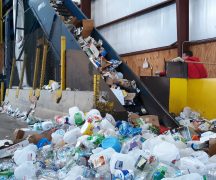By JAN LARSON McLAUGHLIN
BG Independent News
Bowling Green Recycling Center announced last week it is not longer accepting books – but that is only part of the story.
The market has tanked for many of the items collected at the recycling center, according to Ken Rieman, chairman of the center. Not only has the demand dropped for many recyclables, but so has the monetary value of the items, he said.
“China’s not buying anything, so everything is starting to collapse in the U.S.,” he said.
The local recycling center has always operated under the business model that “materials pay their way to market,” Rieman said.
And in the case of books – the bottom dropped out completely.
The recycling center has been the drop off for about 80,000 pounds of books a year – most from individuals, but also many from libraries, schools and groups like the 577 Foundation.
The problem is that recycling books requires a two-step process.
“It isn’t like office paper, where you grind it and take it to the mill,” Rieman said.
The process and machinery for removing bookbinding is very time consuming and very expensive to keep in operation.
“The value of paper is so low, they can’t afford it,” Rieman said.
Earlier this week, the recycling center got rid of its last load of books to a broker in Indiana. The center was paid $40 for a semi-truck full of books.
The domino effect from the recycling center’s decision to drop books had an immediate effect.
“We’re no longer accepting donations,” of books, Wood County District Public Library Director Michael Penrod said. “This town needs a way to recycle books. This is a college town.”
But according to Rieman, the books issue is just one chapter of the recycling story.
“The books are just the tip of the iceberg,” he said.
“Right now we’re operating with a loss. The question is – how long will it be,” Rieman said.
The recycling center has seen tough times before, like in 2008 when the economy bottomed out.
“We’re at the mercy of what the mills will take,” he said. “It’s not about making a profit. It’s about covering costs.”
The problem with China refusing to buy recyclables from the U.S. has been going on about two years, he said.
“China is probably not going to change,” he said.
But there are also other issues impacting recyclable markets.
A big problem is the drop in newspapers – which used to be the highest volume and highest value recyclable.
“Newspaper was the reason recycling got started and was the reason we went curbside,” Rieman said.
A decade ago, the center used to bring in about 1,000 tons of newspaper a year. Last year that dropped to 500 tons, and this year looks like it will be coming in closer to 300 tons, he said.
The tariffs imposed on paper from Canada didn’t help, since it bumped up newspaper costs and led to smaller papers.
“Newspaper was the material that carried the weight for recycling,” Rieman said. “In the past, we would wait things out. But newspapers are never coming back.”
Cardboard prices have also dropped, down to $35 a ton.
“You can’t run the baler for that – but you also can’t store it,” Rieman said.
Aluminum cans bring in 30 percent less than the past, primarily because aluminum plants are now focusing on sheet products, which use a different alloy, he said.
Office paper and magazines are bringing in $140 a ton, compared to the $200 a ton of the past. And that’s if the center can find a buyer. There have been times recently when the market value for mixed paper loads has been negative $5 a ton.
And while plastic and steel can be stored for long periods, paper gets damp and moldy.
Plastic has a local buyer, but payments have been slow.
And steel recycling is also being harmed by tariffs. “It’s started to drop. It’s been a good value,” Rieman said. So it now takes bigger loads to make smaller revenues.
And while more people are recycling, the markets aren’t keeping up. So that means that some recyclables picked up by private programs may not actually be making it to recyclable markets.
“That’s part of the problem. There’s too much supply,” said Scott Rieman, manager of the recycling center.
When times have been tight in the past, the recycling center has just waited it out. As long as there is enough to pay employees and operate the machinery, they can stay in business.
“When times are good, you can take some marginal material. When times are tight,” they don’t have that luxury, Ken Rieman said.
That led to the banning of recycled books.
“We’re going to take whatever we can take and make it work as long as we can,” Rieman said. “We can sustain it for awhile. I can’t tell you how long that is.”
The recycling center is subsidized by Bowling Green and Wood County. The city pays the operation $30,000 a year and the county pays $1.50 per capita.
The recycling center is still struggling with the number of Bowling Green residents who put trash in their recycling containers. Rieman estimated that 16 percent of the items in the recycling bins are trash.
In some cases, it’s a matter of people not realizing which items can be recycled, but in other cases, it’s just “stupid stuff.”
“Meat is the worst. You gag on it,” Rieman said. “When the snow is done, all the broken sleds come in.”
“People think, ‘you ought to be able to do something with this,’” such as the plastic doll that showed up recently. But all those items do is slow up the recycling sorting line.
“Everybody has the idea stuff is worth big money,” he said of recyclables. “If it was worth big money, we never would have gotten into it. Private business would be doing it.”





